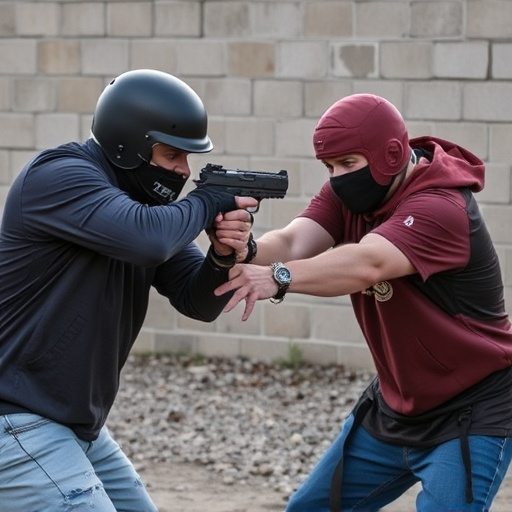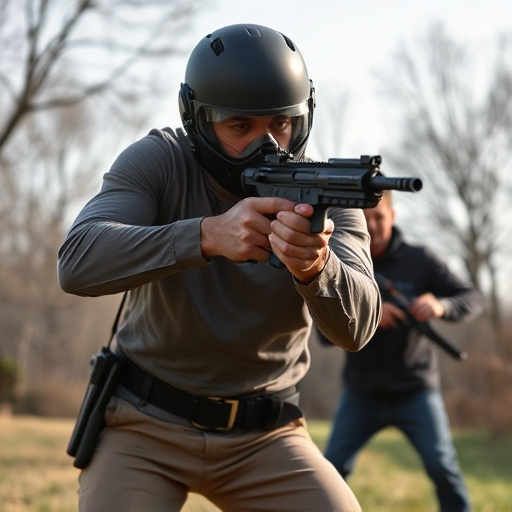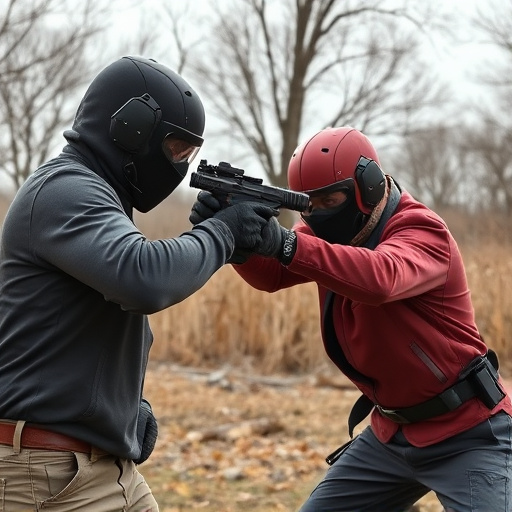Stun guns, or electronic control devices (ECDs), use electric shocks to temporarily paralyze individuals for 5-15 seconds, disrupting nerve signals controlling muscle movement. Higher voltage stun guns target vulnerable areas like the legs, causing a loss of balance and mobility. While commonly misunderstood due to misinformation, average paralysis lasts 1-3 minutes, varying based on factors like stun gun power, targeted area, and individual characteristics. Legal frameworks around ECDs vary globally, with many regions having stringent regulations. Case studies show variable reaction times and potential risks, highlighting the need for proper training and understanding their limitations.
Discover the surprising science behind stun guns and their ability to induce temporary paralysis. This comprehensive guide explores the duration of muscle incapacitation caused by stun guns, debunking myths and delving into the factors influencing their effectiveness.
From the mechanism of action to legal considerations and real-world case studies, we examine every aspect of temporary paralysis from stun guns. Learn how understanding these tools can help navigate safety and legal complexities.
- Understanding Stun Guns and Their Mechanism
- The Science Behind Muscle Incapacitation
- Duration of Temporary Paralysis: Fact vs Fiction
- Factors Influencing Stun Gun Effectiveness
- Legal Implications and Safety Considerations
- Case Studies: Real-World Examples and Lessons Learned
Understanding Stun Guns and Their Mechanism

Stun guns, also known as electronic control devices (ECDs), are non-lethal weapons designed to incapacitate individuals through a powerful electric shock. Unlike traditional firearms, stun guns do not use bullets but rather deliver an electrical current that disrupts the nerve signals controlling muscle movement. This interference results in temporary paralysis, allowing users time to subdue or escape from their target.
The duration of this temporary paralysis varies based on several factors, including the stun gun’s power output and the area targeted. Higher voltage stun guns typically induce longer periods of incapacitation, often ranging from 5 to 15 seconds. The legs are particularly vulnerable, leading to a loss of balance and mobility. This temporary paralysis is a critical component of stun guns’ effectiveness in self-defense scenarios, providing users with a crucial window of opportunity to escape or gain control.
The Science Behind Muscle Incapacitation

The temporary paralysis caused by stun guns, or electroshock weapons, is a result of their ability to disrupt muscle function through high-voltage electrical impulses. When a stun gun delivers its charge, it generates an intense pulse that interferes with the electrical signals responsible for muscle contraction. This interference leads to a rapid and momentary loss of muscular control, causing the target to become immobilized.
The duration of this muscle incapacitation varies depending on several factors, including the power output of the stun gun and the area targeted. Stun guns deliver a short but powerful burst of electricity, typically lasting just a few milliseconds. This brief period is enough to disrupt muscle activity, rendering the individual temporarily paralyzed. While the effects are not permanent, they can last for several seconds, providing an essential window of opportunity for law enforcement or security personnel to secure and control the situation.
Duration of Temporary Paralysis: Fact vs Fiction

The duration of temporary paralysis from stun guns is a topic shrouded in misconception, often exaggerated or underestimated based on popular culture and uninformed sources. In reality, the effects of a stun gun are designed to be non-lethal and temporarily incapacitate the target, allowing for an opportunity to subdue them. The length of this temporary paralysis varies greatly depending on several factors: the power output of the stun gun, the area targeted, the individual’s size, weight, and physical condition, as well as their tolerance to pain.
Studies suggest that the average person may experience symptoms of paralysis for 1-3 minutes after a stun gun deployment, with some individuals reporting an even shorter duration. However, it’s crucial to note that this period can be influenced by external factors like environmental temperature and the individual’s ability to move immediately after the shock. Misconceptions often arise from exaggerated claims or scenarios where special circumstances extend the paralysis beyond typical ranges, leading to a distorted understanding of the actual effects of temporary paralysis from stun guns.
Factors Influencing Stun Gun Effectiveness

The effectiveness of a stun gun, and thus the duration of muscle incapacitation it induces, is influenced by several key factors. One major consideration is the stun gun’s power output, which determines its ability to disrupt muscular function. Higher voltage outputs generally result in longer periods of temporary paralysis from stun guns.
Another critical factor is the stun gun’s probe design and contact points on the target. Probes with larger surface areas or those designed to make multiple contact points can enhance muscle incapacitation by delivering a more concentrated electric current, leading to quicker and longer-lasting effects. Additionally, factors like target size, body composition, and physical condition can also play a role in how an individual responds to stun gun shocks, potentially affecting the duration of their temporary paralysis.
Legal Implications and Safety Considerations

The use of stun guns, also known as electronic control devices (ECDs), has sparked debates due to their potential for causing temporary paralysis or muscle incapacitation. It’s crucial to understand that legal implications vary significantly across jurisdictions. In many regions, stun guns are regulated and their usage is subject to strict laws, often requiring permits or limiting their power output. Law enforcement agencies and security professionals must adhere to these regulations to ensure responsible use.
Safety considerations are paramount when discussing stun guns. Although temporary paralysis from ECDs typically lasts for a short duration, it can still pose risks. Users should be adequately trained in their operation to minimize the chance of accidental or prolonged activation, which could lead to excessive muscle weakness or even respiratory distress. Regular maintenance and understanding of the device’s limitations are essential to guarantee user safety.
Case Studies: Real-World Examples and Lessons Learned

In the realm of law enforcement and self-defense, case studies offer invaluable insights into the effectiveness of stun guns and their impact on muscle incapacitation. Real-world scenarios provide a stark contrast to laboratory tests, revealing crucial details about the duration of temporary paralysis from stun guns. One such study documented a suspect who, after being shocked by a stun gun, experienced complete muscular control loss for approximately 10 seconds, allowing officers enough time to secure and handcuff him without further resistance.
Another compelling example involves a civilian who used a stun gun against an assailant. The victim reported feeling momentarily paralyzed, with their attacker able to retreat and escape before regaining mobility. This case underscores the variable duration of paralysis, as individuals may react differently to the shock. It’s essential to consider these real-world lessons learned, as they highlight the potential risks and benefits of relying on stun guns for self-defense, emphasizing the need for proper training and understanding of their limitations.
The use of stun guns, while controversial, has been studied extensively regarding its impact on human muscles and the duration of temporary paralysis it induces. Understanding the science behind muscle incapacitation from stun guns is crucial for both safety considerations and legal implications. This article has explored various aspects, including the mechanism of stun guns, the scientific basis of muscle paralysis, and real-world case studies. It’s clear that the duration of temporary paralysis can vary greatly depending on numerous factors. As the use of stun guns continues to evolve, it’s important for both users and policymakers to be aware of these variables to ensure their effectiveness and safety in practical applications.
